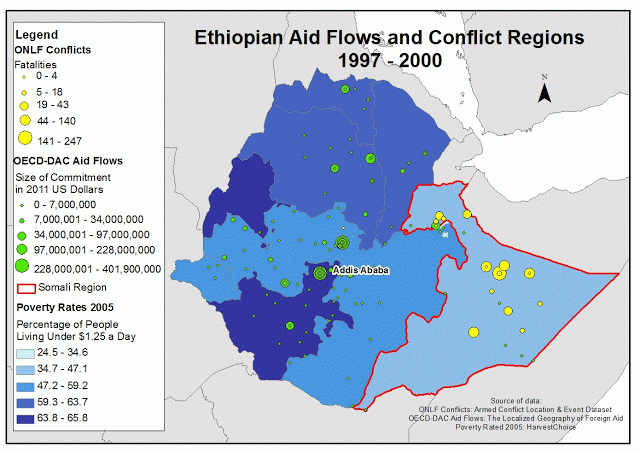Ogaden – an arid, mainly ethnic Somali region in eastern Ethiopia – is largely characterized by allegationsof human rights abuses by the government, vast numbersof Somali refugees and a rebel group seeking political independence. All of these traits contribute to Ogaden’s fragility and should capture the attention of donors. Instead, the region receives low levels of aid from OECD-DAC countries and non-governmental organizations as donor agencies balance improving relations with the Ethiopian national government versus reducing Ogaden’s vulnerability. In this post, I analyze the relationship between conflict events, aid flows and poverty levels in the region as a basis to make recommendations for donor action.
When the 1997 war between Ethiopia and Eritrea ended with a ceasefire in 2000, a surge of economic assistance flowed into the country, but the large majority of this aid did not target the Ogaden region. This lack of aid in Ogaden is likely due to a combination of factors, including: relatively low poverty rates and population density, inaccessibility, and high rates of violence.
Ethiopia and Somalia have fought numerous times over control of the region and Ogaden is home to the Ogaden National Liberation Front (ONLF), a rebel group demanding political independence. Conflict increased steadily from 2003 to 2009, and included one disastrous incident where ONLF troops attackeda Chinese-owned oil refinery, killing over 74 workers. China responded by increasing military aid to the national government. Even now, NGOs and travellers remain heavily restricted in the area. With economic interests at stake for its residents, the region’s large reserves of oil and natural gas could galvanize local support for the ONLF in the near future. Further complicating donor decisions will be the growth of the humanitarian crisis regarding 240,000Somalian refugees in Ethiopia.
What actions might donors take to curb alleged human rights abuses, while ensuring that more aid flows into the region? What types of development programs can most effectively address systemic, sub-national conflict in Ethiopia, and where exactly are they needed? Below are four maps of conflict events associated with the ONLF along with aid flows of OECD-DAC donors overlaid with regional poverty indicators. The animated map below shows changes in Ethiopian aid flows and conflict regions across four periods: 1997-2000, 2001-2003, 2004-2006, and 2007-2009.

The conflict in Ogaden can create a downward spiral. Donors are unable to establish a presence in the region due to violence, but the lack of aid and relief may further contribute to the underlying economic and political conditions causing the violence in the first place. The maps suggest that channeling aid to the central government (represented by the centroid in Addis Ababa) has not helped alleviate this problem, and has only increased social tensions between Ogaden’s residents and government officials. The location of the aid that exists in the region does not appear to correlate with the major conflict areas, suggesting that the current aid flows are not going to the right places within Ogaden. Furthermore, many of the conflict regions within Ogaden appear to be centered in the northern and central parts of the region. With the growing numbers of Somali refugees in the southern most part of the Ogaden region, tensions could fuel even more conflict in that area.
If donors are to meaningfully address this question of violence in Ethiopia, a careful reevaluation of the ultimate purpose of development assistance is needed. Do donors want to emphasize the central goal of economic growth or the alleviation of conflict in regions like Ogaden? Donors can start by applying the frameworkthe Asia Foundation has developed in subnational areas in Southeast Asia towards African countries like Ethiopia where secessionist movements exist. Aid projects must be created with conflict reduction as the main goal, not just as a by-product of general development goals. These aid projects must also respond to local conditions by focusing on region-specific issues, addressing the problems that inequalities can bring, and incorporating more local involvement in the design, implementation and evaluation of projects.
One specific solution already being undertaken by the Department for International Development (DFID) involves creating a human rights training program for the local police force in Ogaden, called the Liyu, helping them build local resilience while avoiding the tensions associated with national forces from Addis Ababa. Donors must also dissuade the central government from imposing harsh martial control at the expense of long-lasting legitimacy. If the government cannot address some of the claims its detractors in Ogaden have levied against it, and if donors fail to address these problems in their aid strategies, then the cycle of instability will only continue.